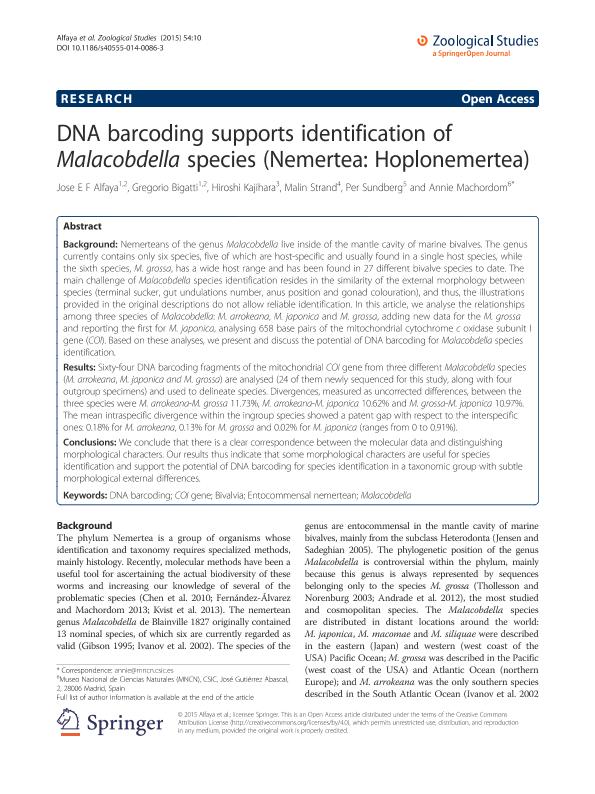Artículo
DNA barcoding supports identification of Malacobdella species (Nemertea: Hoplonemertea)
Fernandez Alfaya, Jose Elias ; Bigatti, Gregorio
; Bigatti, Gregorio ; Kajihara, Hiroshi; Strand, Malin; Sundberg, Per; Machordom, Annie
; Kajihara, Hiroshi; Strand, Malin; Sundberg, Per; Machordom, Annie
 ; Bigatti, Gregorio
; Bigatti, Gregorio ; Kajihara, Hiroshi; Strand, Malin; Sundberg, Per; Machordom, Annie
; Kajihara, Hiroshi; Strand, Malin; Sundberg, Per; Machordom, Annie
Fecha de publicación:
10/01/2015
Editorial:
Springer
Revista:
Zoological Studies
ISSN:
1810-522X
Idioma:
Inglés
Tipo de recurso:
Artículo publicado
Clasificación temática:
Resumen
Background: Nemerteans of the genus Malacobdella live inside of the mantle cavity of marine bivalves. The genus currently contains only six species, five of which are host-specific and usually found in a single host species, while the sixth species, M. grossa, has a wide host range and has been found in 27 different bivalve species to date. The main challenge of Malacobdella species identification resides in the similarity of the external morphology between species (terminal sucker, gut undulations number, anus position and gonad colouration), and thus, the illustrations provided in the original descriptions do not allow reliable identification. In this article, we analyse the relationships among three species of Malacobdella: M. arrokeana, M. japonica and M. grossa, adding new data for the M. grossa and reporting the first for M. japonica, analysing 658 base pairs of the mitochondrial cytochrome c oxidase subunit I gene (COI). Based on these analyses, we present and discuss the potential of DNA barcoding for Malacobdella species identification. Results: Sixty-four DNA barcoding fragments of the mitochondrial COI gene from three different Malacobdella species (M. arrokeana, M. japonica and M. grossa) are analysed (24 of them newly sequenced for this study, along with four outgroup specimens) and used to delineate species. Divergences, measured as uncorrected differences, between the three species were M. arrokeana-M. grossa 11.73%, M. arrokeana-M. japonica 10.62% and M. grossa-M. japonica 10.97%. The mean intraspecific divergence within the ingroup species showed a patent gap with respect to the interspecific ones: 0.18% for M. arrokeana, 0.13% for M. grossa and 0.02% for M. japonica (ranges from 0 to 0.91%). Conclusions: We conclude that there is a clear correspondence between the molecular data and distinguishing morphological characters. Our results thus indicate that some morphological characters are useful for species identification and support the potential of DNA barcoding for species identification in a taxonomic group with subtle morphological external differences.
Palabras clave:
Dna Barcoding
,
Coi Gene
,
Bivalvia
,
Entocommensal Nemertean
,
Malacobdella
Archivos asociados
Licencia
Identificadores
Colecciones
Articulos(CCT-CENPAT)
Articulos de CTRO.CIENTIFICO TECNOL.CONICET - CENPAT
Articulos de CTRO.CIENTIFICO TECNOL.CONICET - CENPAT
Citación
Fernandez Alfaya, Jose Elias; Bigatti, Gregorio; Kajihara, Hiroshi; Strand, Malin; Sundberg, Per; et al.; DNA barcoding supports identification of Malacobdella species (Nemertea: Hoplonemertea); Springer; Zoological Studies; 54; 10; 10-1-2015; 1-9
Compartir
Altmétricas



